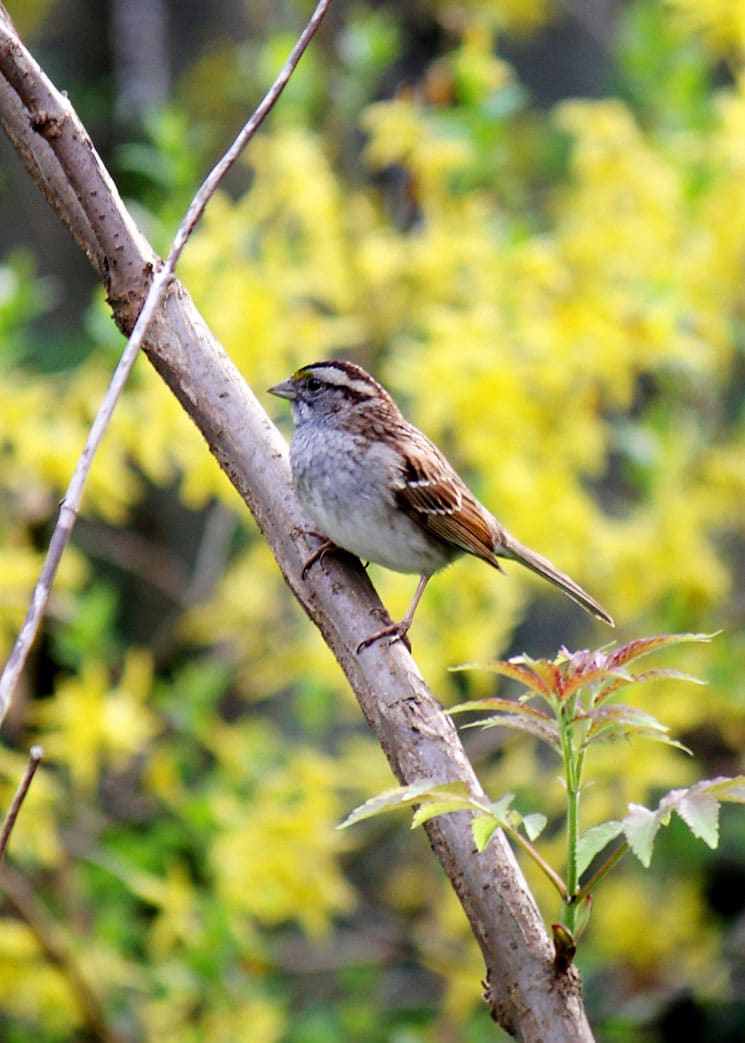
My garden is full of little birds, more than I’ve seen in recent years. Robin couples are being flagrantly domestic, and made early claims to the worms in the lawn. The mature shrubs are atwitter with nesting cardinals, and there are also downy woodpeckers, nuthatches, juncos, finches, black-capped chickadees (calling “yoo-hoo”) and an assortment of melodious sparrows. The striped song sparrows with their extended chirping, and white-throated sparrows singing “my sweet Canada, Canada, Canada” are serenading me through the days of early spring.
I know bird populations adjust to the ebb and flow of insects present in a growing season. Certainly the warm winters we’ve experienced recently have favoured the survival of many insect eggs and larvae that, in colder years, would be diminished by deep frost. Insects are the favoured food for nestlings that need protein for rapid growth. The three birdbaths in the garden are also an important draw for every kind of bird, and well used from early spring to late autumn. Frequently, there are birds lined up and waiting for an opportunity to get in the bath before another species claims it.
The key to having a well-used birdbath is to keep it clean and provide fresh water almost every day. Birds are surprisingly fastidious, and will avoid bathing in a murky bowl (although mosquitoes like it for their larvae). A birdbath is an entertaining feature in any garden, and you won’t mind the small effort of keeping it clean. (This is a circumstance in which cleanliness is its own reward!) Here’s how I do it. The water stays clean longer in cool spring and autumn temperatures, and could be changed every second day. But if the bath is popular, there are days when the bowl is empty and will need water added every day, or even twice a day. In summer heat, the bath certainly needs fresh water daily to prevent the growth of excessive algae and bacteria. I have a dedicated plastic broom that I use to swish out any remaining old water and debris before adding fresh water from the hose.
Once a month (from April through November) I scrub the concrete bowls with a stiff wire brush to remove algae that accumulates in the bottom of the bowl. The wire brush is quite effective and cleans quickly in just a minute or two, with no chemical cleansers required. A solution of one part liquid chlorine bleach to nine parts water is sometimes used for this purpose, but the smell lingers in the garden and is unpleasant. The wire brush does a good job of removing everything from the bowl, with no danger of birds coming into contact with cleaning chemicals.
Birds sometimes take their time finding a new birdbath, but once they feel secure about using it, you can expect them to show frisky enthusiasm. Now that the birds are well acquainted with the spa facilities in my garden, I sometimes hold the hose up high and let fresh water spill noisily into the bowls. The sound draws birds quickly, and I can see them gathering to race for the first dip. Before I can get back to turn off the hose tap, they’re already splashing.
Other posts by Judith this week:
Posts by Judith last week:








